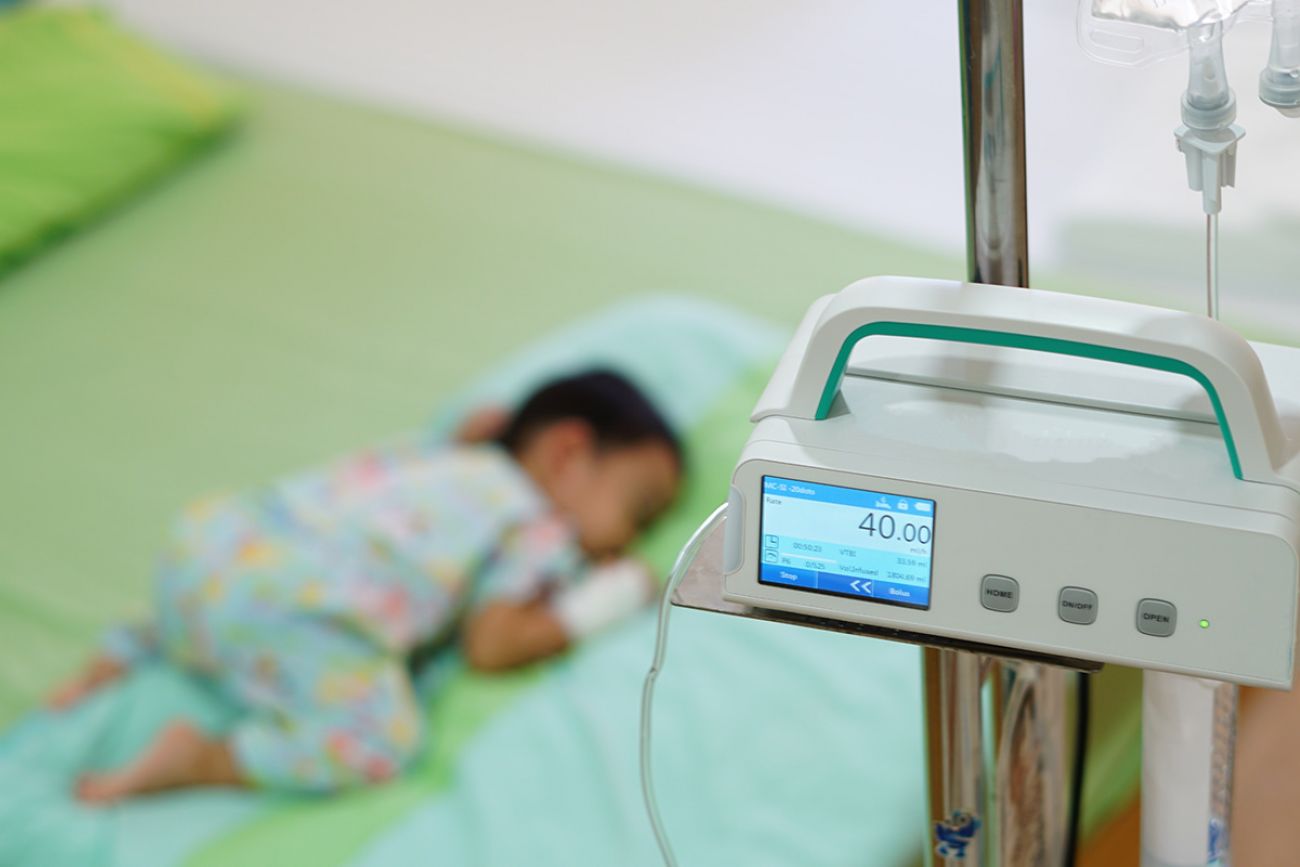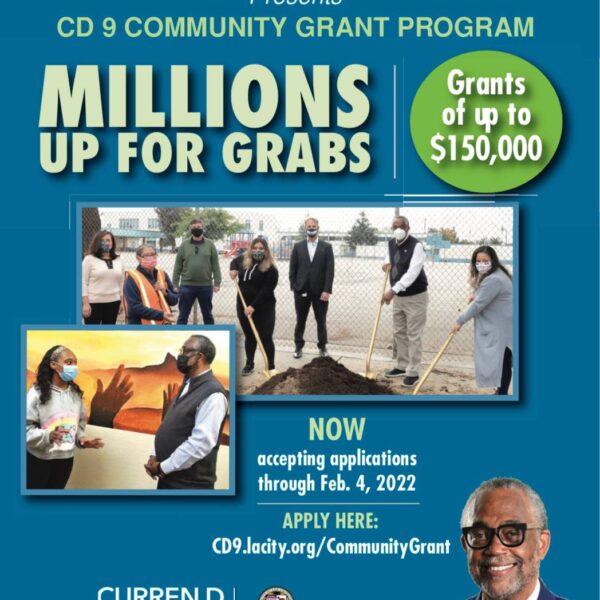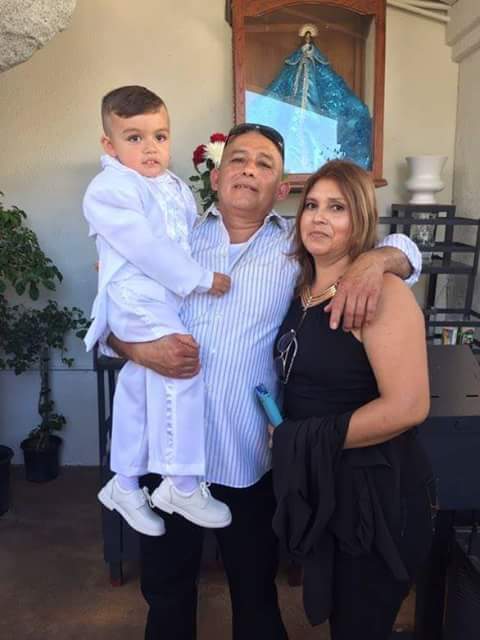A new study estimates that 1 in 50 deaths of otherwise healthy children under age 5 around the world is due to a common virus that’s currently surging in the US: respiratory syncytial virus, or RSV. Pediatric intensive care units around the US are overflowing or at capacity with children experiencing RSV.
At a Q & A briefing hosted by Ethnic Media Services and moderated by EMS Health Editor Sunita Sohraji, experts and medical professionals discussed the causes related to the surge of cases; how parents can distinguish between RSV, a cold, and Covid-19 in their young children, preventive measures – especially vaccines and boosters – and therapeutics and treatment.
EMS Health Editor Sunita Sohraji: Dr. Manisha can you please give us an assessment of what you are experiencing in your practice as far as RSV is concerned?
Dr. Manisha Newaskar, Clinical Assistant Professor, Pediatrics – Pulmonary Medicine, Stanford Medicine Children’s Health: At this point what you are seeing is definitely a surge in the number of cases in pediatric patients who have I would say definitely RSVP and also other vital illnesses. Definitely, it’s been going around and we are seeing a lot of emergency room visits and hospitalizations due to not only RSV but there are other viruses also that are leading causes of hospitalization at this point.
EMS: Dr.Soni we are seeing increases and learning that the Pediatric units are at capacity or overflowing is that what you are saying as well?
Dr. Priya Soni, Pediatric Infectious Disease Specialist, Cedars- Sinai Medical Center: Well, I’d like to start by saying that yes we are experiencing an uptick in hospitalizations in our pediatric patients similar to what many of our colleagues around the country are experiencing, but I will say that I feel that we may not be seeing the worst of it just yet. We are at the start of the line behind here on the West Coast and so we are buckling up for what may be a very busy winter on the kids’ floors.
EMS: Dr. Hakim what are you seeing at South Central Family Health Clinic?
Dr. Mina Hakim, Pediatrics Specialist, South Central Family Health Center, Los Angeles: First of all what we’re seeing here is kind of an alarming trend with an increase in respiratory illnesses and viruses in young children. The trend is not very unusual in itself as the number of patients, but what’s unusual is the timing of it. What we’re seeing here is that it’s only early November, end of October and we are seeing an uptick where we would see in January or December, January, and February, where the biggest and the highest of the spike usually happens. So what we’re seeing right now is the very highest spike which is alarming for us, we see very much of an increase in respiratory illnesses with children coming in and it’s alarming for us because we don’t know what’s going to happen the rest of the season which might mean we will continue spiking to even further and further numbers. And as we were talking about this it is coming to a point where it’s overwhelming our ERs, our ICUs, and our hospitals. So if it continues to spike, that might mean a very dangerous area for us or we can also see that the spike is now instead of later where things will calm down and then spike again later in the season. So we are very very cautious here and we’re taking all precautions to kind of get ready for the worst which is very unusual to see this early.
EMS: Dr. Soni please lay out the scope of pediatric RSV, how to distinguish it from a cold or covid, data on the number of cases, and when do parents need to take their children to the ER.
Dr. Priya Soni: What is RSV? RSV stands for, respiratory syncytial virus, it is a very common winter virus that we do see spike a little bit later in the season but it’s been around for many many decades and we do have a predictable seasonality to it. But we’re seeing now that the spike in cases has kind of surpassed many other types of respiratory viruses so we are seeing a little bit of everything.
Why is this happening now at this stage in the covid pandemic which we are still in?
As children go back to school unmasked, they are mingling with each other, and because many of these children have not lived through a normal winter respiratory viral season, they may not have formed an immunity to many of these viruses that they’re seeing for the first time.
What are the symptoms?
The three main ones that I’d like to focus on would be RSV, influenza-flu, and covid-19, a little bit of each of those right now, and they all kind of have some of the same similar symptoms.
They can present with cough, runny nose, fever, or sore throat, however, an important distinction between RSV and flu or RSV and covid is that with flu the symptom onset is very very quick and you may have some other systemic findings including body aches, fatigue, high fever, and headache. These may be your presenting symptoms, of course in a young baby that’s very hard to differentiate and so any child or infant, specifically, less than 6 months of age with cough, congestion, or fever we really need to keep an eye out on the progression of that baby’s symptoms because these viruses can be particularly complex and devastating in that particular age group.
With RSV, focusing on our young babies, this winter virus typically happens in stages and you’ll see maybe some subtle findings at first where the baby may not be eating as well, maybe some coughing or sneezing, runny nose, there may or may not be fever with RSV in babies this young but they may progress over the next few days to have respiratory distress, difficulty breathing and poor feeding. It’s always important to really make sure to have a good line of communication open with your pediatrician, or primary care provider for your children during this time to make sure they can be seen if needed for further evaluation.
EMS: Can you compare California to what we’re seeing in the rest of the nation? Is this unique to California than it is to the rest of the country?
Dr. Priya Soni: I think California’s RSV surveillance right now is very similar to what we’re seeing across the board all over the country. With influenza, the flu rate we are seeing is a massive increase in cases in the southeast part of our nation right now, particularly in Georgia, and Florida, so we may see our specific flu peak later, and then we don’t really know how that will go. We hope that everything doesn’t coincide at the same time as RSV surging, but we are seeing an uptick in flu cases as well. So it’s something to be mindful of as we are headed into the holiday season where I know a lot of folks will be traveling around the country.
EMS: Can you get multiple viruses at the same time?
Dr. Priya Soni: That’s a great question, kids can get cold infections with covid and RSV which I have seen in the last week. I’ve seen many other viruses that can coexist with each other in one patient and so that can be super alarming for the caregivers as these kids may feel like they’re getting better and then they get hit with another virus on top of that or it may just seem like a prolonged singular illness and so that’s something to be aware of too that they can happen at the same time but it’s important to understand that testing for RSV, flu, and covid are very readily available at Urgent Cares, emergency rooms and in many pediatricians’ offices.
EMS – media partner (Manny Otiko): How do you get the virus and would mask help stop the spread?
Dr. Priya Soni: Yes, RSV is a contact virus and may live on surfaces for much longer periods. You get this through contact, touching surfaces, door knobs, handles, etc. Make sure you are hand washing, as well as consider wearing masks around symptomatic patients, especially in the winter.
EMS: So many of our children are in facilities like daycare etc. and they’re co-mingling how do we keep them safe in such situations?
Dr. Priya Soni: That’s a tough question and it’s a question I know so many parents ask themselves every day as they’re dropping their kids off and I know there have been many many sick kids out, and parents out taking care of them at home. The main thing is not to send your child to daycare, or school if they are sick or coming down with any type of illness, and that’s the main thing. Even if they start off with some sniffles and a low-grade fever best to keep them at home before sending them so please remember that.
EMS media partner Henrietta Burroughs: Do we know the origins of this virus?
Dr. Priya Soni: RSV virus has been studied since the fifties and I don’t know the exact origin but we did know that around that time scientists started studying it, it has come to be known now as a very common cause of respiratory illness in the winter months. With influenza, there are different strains every year so we have updated flu vaccines, RSV hasn’t changed very much. Though I don’t know the exact origins of RSV, I will say that what we’re experiencing now is pretty much the same virus as before.
EMS media partner- Mohsin Zaheer: Doctors are recommending boosters and flu vaccines, If somebody gets a flu shot or flu vaccine would it be good for the RSV virus and why are mainly children catching this virus?
Dr. Priya Soni: The flu vaccine is just for the flu it will not cover RSV since it’s a distinct virus. As for RSV vaccines, we do not have any although there are several promising studies on the horizon that have been done and that are in Phase 3 clinical trials for pregnant women, so we’ll hear more about that in the coming seasons. The reason babies are getting ill, it’s really because they have smaller airways and they’re not able to clear secretions like older adults. For us, a virus can be just a mild cold but babies can get bronchiolitis and other complications so it’s really important to support the baby to make sure we’re clearing the secretions manually for them. Unfortunately, there is no treatment or therapeutic antiviral for this virus.
EMS: If you go to see a pediatrician the doctor only treats the symptoms and may not do a test so how do parents actually know that their kids have RSV?
Dr. Priya Soni: The goal of going to the pediatrician early is to kind of get an assessment of the baby and see where they are in the stage of illness, and to see if additional measures may be needed including IV fluids or oxygen support. The pediatrician will really take a good physical exam and listen to the child to see if there are any risk factors for this particular child on getting worse with the illness. It is always a great idea to communicate with them and to have the baby seen, but I think maybe some pediatricians may not have the rapid antigen testing and it can be difficult to kind of tease out what is going on exactly. In those cases, it may be helpful for them to rule out whatever they have in-house, whether they have the flu, rapid test for covid, or antigen test, at least rule out those things, and urgent care and emergency rooms definitely have testing for this and in some cases, they will test all three viruses with 1 rapid test and you’ll know the answer in 15 minutes or so.
EMS: What is the one takeaway for parents and caregivers?
Dr. Priya Soni: The most important thing is first to prepare. There are many ways that parents can prepare for the respiratory season. One of the ways is by getting nasal suctioning devices that can help clear secretions in small babies who may need help, the other is getting a humidifier, investing in a humidifier is really helpful during the respiratory season. This dry air in California allows these viruses to also spread and multiply a little bit more, so keeping the air nice and moist is very helpful. The second thing would be to communicate as I mentioned a couple of times so far, definitely communicate with your pediatrician, and let them know if your child is not feeling well. They will provide support and they know your child the best, the last is definitely protection, get your flu vaccine if you haven’t, and have your child get the flu vaccine. If they’re six months and above they are eligible, there hasn’t been a more important time to get your flu vaccine, and finally to get your covid booster, so please please consider those things as very important steps in protecting your family.
EMS: Dr. Manisha Newaskar a pediatric pulmonologist please lay out the prevention and treatment strategies emphasizing the role of vaccines and boosters possible cures in the pipeline what types of support services are available in the absence of a cure.
Dr. Manisha Newaskar: Just to give a background, we know that RSV is basically a leading cause of respiratory disease in infants and it especially affects infants less than 6 months old but honestly, it affects all age groups. It’s like a regular common cold for older children and adults. Adults don’t show the severe symptoms that we would see in a small baby and oftentimes that’s how we spread it to little kids. Actually, studies have shown that almost all children would have had RSV infection by their second birthday.
So how does RSV affect your lungs?
Some common symptoms: In most people, it will be just like a cough and runny nose and some mild fever symptoms but in babies, it can cause bronchiolitis or pneumonia. Bronchiolitis is a condition where there is inflammation of the small airways of the lungs. Essentially, babies and infants have very very small bronchial tubes so any swelling or mucous collection can make it very difficult for a baby to breathe which can result in low oxygen levels making them work really hard to breathe which can result in dehydration. There are some babies who will end up with acute respiratory failure which means that they may end up being in an ICU and needing ventilator support. There are some babies who are more sort of predisposed or are at higher risk for developing RSV and it’s important to know that babies who are born really premature have a higher risk of contracting severe RSV and babies with underlying medical conditions like heart disease or any kind of neuromuscular disease, immunodeficiency, those are more likely to have a severe course if they catch RSV. Really there is no actual treatment for this. Unfortunately, there’s no antiviral medication available and antibiotics are not helpful. Typically, you clear the nasal passages because for most babies the most common symptom they may have is clogged up nasal passages and secretions, and what we know is that babies mostly breathe through their noses, they haven’t quite learned how to use their mouths to breathe which can result in a lot of struggle to breathe. So having apparatus where you can do nice suctioning of the nose, using humidifiers to keep the secretion moist and easy to kind of suction out is very important. Sometimes it’s basics like just using bulb suction to suction the nose, that can help the baby breathe so much better and of course, fever control with things like Tylenol, and acetaminophen can be helpful. The most important thing is to also make sure that the baby is hydrated well because when the baby is not feeling well they don’t like to eat or feed, so there may be decreased appetite because they’re breathing hard which can lead to decreased oral intake and they often get dehydrated very easily. Also, many babies when they present to the emergency room are very dehydrated and a lot of times we have to put them on intravenous fluids. As mentioned earlier, RSV causes bronchiolitis or swelling of the breathing tubes which can result in low oxygen levels leading many babies to end up in the hospital on oxygen support. Usually, things like steroids and breathing treatments are not helpful treatments and as I mentioned earlier that unfortunately there are no antibiotics that would be helpful so the treatment is mostly what we call supportive therapy, meaning making sure that we suction the passages, we give them oxygen if needed, we give them IV fluids to keep them hydrated and we just give them respiratory support in the hospital as the disease runs its course and it slowly gets better.
In terms of prevention, Dr. Soni also mentioned that RSV is spread mostly through contact and droplets so, by person-to-person contact with their secretions, and there are some data that say that the RSV virus can survive up to 30 minutes or more on unwashed hands and it can survive on surfaces up to 6 hours, so it’s really important that you’re actually washing your hands thoroughly. A lot of times we discuss in clinics and hospitals that it’s really important that caregivers or whoever, including the children, are taught how to wash their hands thoroughly, avoid crowded places, and wear masks especially if you are having some respiratory symptoms and if you feel like you’re coming out of a cold it’s a good idea to wear a mask. Also, it’s a good idea to keep your child at home when they are sick because that’s how you prevent the spread of viruses inside a daycare or school. So taking that precaution is really important. There is one more precautionary measure that we can take. There is something called Synagis, it is a vaccine that is given to high-risk infants and it can prevent severe RSV disease. And the high-risk infants, basically infants who were born very premature. There are certain guidelines, so only really premature babies are eligible candidates for that. If your baby is born healthy, full-term they are not eligible. These are monthly Injections that are given during a typical RSV season. Starting late October through March every year it’s being given and while it doesn’t prevent the baby from getting RSV, it will prevent them from getting severe illness so that they don’t end up in the hospital with respiratory failure. Essentially it’s targeted for really really high-risk infants and it’s usually given to infants definitely below one year of age with the pre-maturity, but there are some extremely premature babies who were born before 28 weeks of gestation, and sometimes they are eligible for it in the second year of their life.
EMS: Everyone assumes that we have these doctors that we can call upon as needed but many people do not and I’m hoping you could talk a little bit about that.
Dr. Mina Hakim, Pediatrics Specialist, South Central Family Health Center, Los Angeles: We have a very large clinic here in South Central and though we have very experienced doctors we only have one pediatrician here who is me, and one pediatric physician assistant who is seeing pediatric patients. For such a large area that we’re covering, access to a pediatrician can be very very very difficult. So as opposed to other populations or other areas in different places where your pediatrician is just one call away, there are people who usually see either a regular non-pediatrician or do get their vaccines through other means and don’t actually come and have a pediatric visit, they don’t have an established care with a pediatrician so that is a huge problem that we’re having. We try to kind of put a stop to that by creating fitted qualified health centers like South Central has and free clinics and hospitals. Some hospitals and clinics will also have nursing lines that you can call ahead of time if you have any concerning symptoms. Access and the quality of care that people are having can change the outcome.
Who is at risk?
Talking about the certain population that is at risk underlying the more important part includes environmental aspects that can put you at increased risk for RSV. Certain populations are at high-risk: we find that Caucasians, Hispanics, and American Indians have the highest risk for RSV. This year so far according to The CDC we’ve had two hospitalizations per 100,000 for RSV, and they are finding out that they’re seeing a whole lot more Hispanic and American Indians that are being hospitalized for RSV, especially this season. The population that is at highest risk are children at less than 6 months of age, so that’s the highest risk population. The general overall rate for a year to-year of hospitalization for RSV is about 13 per 100,000 so that’s a point .013 percent of hospitalization, that’s for the general population, for children the risk is for children less than 6 months of age, the hospitalization rate is up to 2% so there is a more than in a hundredfold difference there in the hospitalization rate. That can give you an idea of how 6 months of age and fewer infants in babies are at a higher risk. So premature infants and specifically those born at less than 29 weeks at a time of birth are at high risk.
Babies that are taking medicine for their lungs from a young age puts them at a very very high risk, as well as heart disease especially heart disease that causes you to have blue discoloration from time to time, and f you have a cardiologist that you go see at irregular intervals, so high risk of heart disease can put you in a very much higher risk. Other conditions are asthma, cystic fibrosis, and muscular dystrophy, things that can decrease your immune system, and can put you at high risk. One condition that we don’t really talk about often is malnutrition, so if we’re talking about children and families who don’t have good access to food and formula and breastfeeding can have a higher risk for RSV as well.
The environmental factors: Environmental factors are sometimes things that we should be able to control but in certain situations, 95% of my patients are below the poverty level and that can for several reasons put the kids and their babies at higher risk. So first of all smokers, smoking or exposure to smokers can very much increase your risk for bronchiolitis, severe bronchitis from RSV, land you in the hospital and studies have found that kids who are exposed to smoking at early stages are more likely to be in the hospital due to RSV. For babies, it was found that 3 months of breastfeeding can decrease your risk for severe bronchitis from RSV. That count is important because most of my patients for example are patients who have one or two jobs and they really can’t be outside of a job for so long to pump or to breastfeed and end up breastfeeding for the first couple of weeks or for the first 3 weeks where they can get off and then they stop breastfeeding which I encourage them to breastfeed for as much as possible but there is a barrier to that when it comes to economic status. Parents and mothers face the reality of life having to go back to work sooner than other populations. Breastfeeding for more than three months or more will decrease the risk of bronchitis or RSV. A house packed with multiple children or husbands and spending time in crowded areas count as especially important, the more contacts you have the more people around you, and the more likely that you’re going to be in contact with the virus. As opposed to little babies, that can have a brother, or an older brother who is 15 years old, that has a little sniffle, a little cough and doesn’t know that this is RSV, comes back home to a two-month-old or to a 1-month-old at risk and then transmits the virus. So why I’m touching on that is because again if we’re talking about low social economic status, especially in Hispanic populations where we have multiple, not only one large family in 1 house, we are having multiple large families that live in or are living in the same area together where there are maybe contact with 10, 12, 15 children in the same house, where this person is going to this school, that person is going to that school and each one of these contacts is a risk for contracting RSV, as they are spending time at crowded areas. Again the more inner-city you go, the more you know that just going to the store can put you in contact with a whole lot more people who are living in the suburbs or end up in a little more crowded areas. Another risk factor is older houses, specifically houses built before 1990 were found to increase your risk for having severe bronchitis from RSV probably due to environmental exposure.
In a nutshell, this holiday season be mindful of the immuno-compromised and practice all safety measures to keep babies and vulnerable adults safe.







